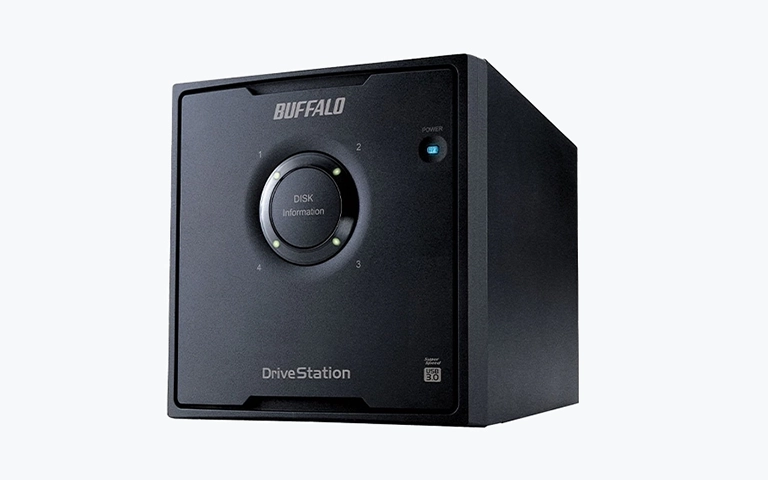A client approached us after one of the drives in their Buffalo LinkStation Pro Quad NAS failed, resulting in sudden loss of data access.
The issue started with subtle warning signs that were easy to overlook, such as slower system performance, delayed file access and occasional read errors. Soon after, the NAS stopped responding completely.
Although the unit powered on and appeared operational, none of the shared folders were accessible from connected systems.
The client also reported hearing clicking sounds from one of the drives, a strong indication of mechanical failure. Recognising that continued use could cause further damage and permanent data loss, they decided to stop all activity and contact us for professional recovery assistance.

Client Situation: Sudden NAS Inaccessibility
The Buffalo LinkStation Pro Quad contained several years of vital business data, including internal documents and archived project files. When one drive failed, the RAID array degraded and the NAS became completely inaccessible.
Attempts to access the device from multiple computers resulted in repeated network errors, and the shared storage volume no longer appeared on the system.
At first, the client suspected a simple configuration fault. However, further review showed the RAID status had degraded and one of the drives was producing read errors.
To prevent further data corruption, they powered down the unit immediately and contacted our recovery engineers for a full diagnostic assessment.
Common Causes of Buffalo NAS Data Loss
Data loss in Buffalo LinkStation systems can occur for various reasons. Our engineers frequently encounter the following issues during recovery:
Drive Failure: Internal hard drives can develop bad sectors or mechanical faults, resulting in unreadable data.
RAID Degradation: When one or more drives drop out of the RAID array, the system becomes unstable and may fail to mount correctly.
Firmware Corruption: Interrupted updates or power interruptions during firmware installation can leave the NAS unresponsive.
Power Surges: Sudden electrical fluctuations can damage the controller board or interfere with RAID configuration data.
User Errors: Actions such as accidental formatting, incorrect configuration or unsuccessful rebuild attempts can overwrite essential metadata and file structures.
Understanding these potential causes helps users recognise early warning signs and act before permanent data loss occurs. For further details, see our article on Common Reasons for RAID Data Loss.

Our Buffalo LinkStation Recovery Process
When the failed Buffalo LinkStation Pro Quad reached our lab, our engineers carried out a detailed recovery procedure to ensure complete data safety and accuracy.
The NAS enclosure and all installed drives were examined to identify any hardware faults and determine the extent of the damage.
Each drive was cloned using specialised, write-protected imaging equipment to preserve the original data and prevent further deterioration.
Our team analysed the RAID metadata and rebuilt the original configuration, including the correct stripe order and block size.
Engineers repaired damaged directory entries and restored access to shared folders, business documents and archived data.
Recovered files were verified with the client to confirm that all content was complete, consistent and accessible before final delivery.
In some cases, controller incompatibility can add complexity to the process. To learn how such failures are resolved, refer to our article on RAID Controller Failure Recovery.

Successful Data Recovery and Client Outcome
After rebuilding the RAID array and repairing damaged file structures, our engineers successfully recovered all stored data from the Buffalo LinkStation Pro Quad. The restored data included business records, archived project folders and essential client documentation.
During the verification session, the client confirmed that every recovered file was functional and complete. Once validated, the data was securely transferred to a new NAS with redundancy enabled, allowing the business to resume daily operations without disruption.
Fast turnaround times for business-critical data
Tips to Prevent Buffalo NAS Data Loss
Preventing data loss in Buffalo NAS systems starts with regular maintenance and proactive monitoring. Users can reduce the likelihood of failures by following these key practices:
Schedule regular backups to an external drive or a secure cloud storage service.
Replace ageing drives before they fail or begin showing SMART warnings or performance issues.
Keep NAS firmware updated to prevent compatibility problems and software-related faults.
Use surge protection to safeguard the NAS from electrical fluctuations and power outages.
Avoid DIY RAID rebuilds or reconfiguration without a professional assessment, as this can overwrite vital data structures.
Applying these practices helps maintain system stability and ensures long-term data protection. For more details about early warning signs and preventive actions, see our article on Common NAS Data Loss Causes.
Need Help with Buffalo LinkStation Recovery?
If your Buffalo LinkStation NAS has failed or become inaccessible, professional recovery is the most secure way to restore your data. Our engineers specialise in Buffalo NAS data recovery, including LinkStation and TeraStation models affected by drive faults, RAID corruption or controller failure.
We provide secure diagnostics, precise RAID reconstruction and verified data delivery to ensure every recovered file is safe and accessible.
Contact RAID Recovery Services today to arrange an expert evaluation and regain access to your critical data.

Trust the experts with proven results
Frequently Asked Questions
What causes a Buffalo LinkStation Pro Quad to fail?
Typical causes include hard drive failure, power surges, firmware corruption or RAID degradation. These issues can leave the NAS unresponsive or prevent access to stored data.
Can I rebuild a failed Buffalo LinkStation RAID myself?
It is not advised. Rebuilding without correct imaging or RAID configuration knowledge can overwrite data and make recovery impossible. Always consult a professional before taking action.
How long does Buffalo NAS data recovery take?
The timeframe depends on the condition of the drives and the RAID complexity. Most Buffalo LinkStation recoveries are completed within a few business days following diagnostics.
What should I do if my Buffalo NAS is not accessible on the network?
Power down the NAS, label each drive clearly and avoid rebooting it. Contact a professional data recovery service to prevent additional damage and increase recovery success.
Can all data be recovered from a failed Buffalo LinkStation Pro Quad?
In most cases, yes. If the drives are physically readable and not overwritten, full data recovery is usually achievable through professional imaging and RAID reconstruction.